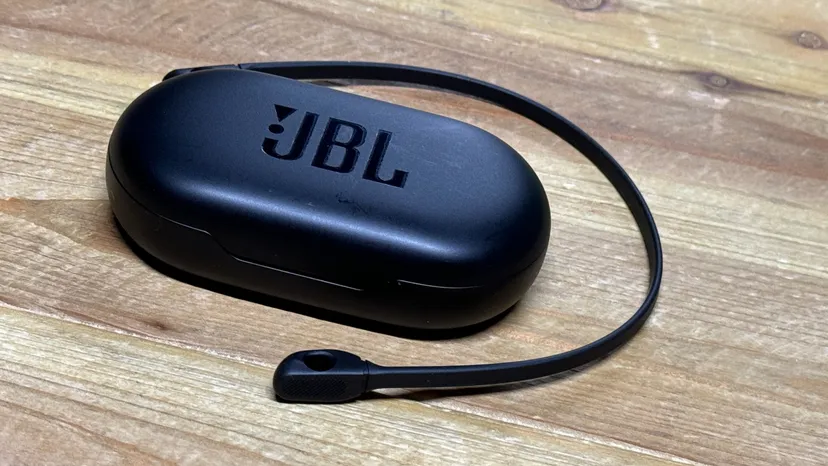- The JBL company has presented the SoundGear Sense as an option for open true-wireless headphones with support for the ear and designed for the most athletic users.
- They are headphones that allow you to fully hear your surroundings while continuing to hear the music in a very natural way.
There are many models of true-wireless headphones on the market. This category concerns small headphones that you can recharge in a box that you carry with you.
Within this type of headphones there are in-ear models (with a silicone/foam tip) or open design, superimposed on the ear canal.
These JBL are a model that are not even superimposed, like traditional headphones, but rather they are attached with a hook that goes behind the ear and are located at the height of the ear canal.
I have been able to spend about two weeks with them and I will tell you what my impressions and my analysis of this SoundGear Sense model have been.
I can tell you that I was positively surprised by its autonomy and the transparency of sound it offers as well as its box, and not as I would like.
- Features and technical data sheet of the JBL SoundGear Sense
- Bet on an open solution for all users
- Control and connectivity app: JBL Headphones, multipoint and Fast Pair
- Sound quality and autonomy: Open sound, without noise cancellation and higher battery life
- Versions, offers and price of the JBL SoundGear Sense
- Conclusion: JBL SoundGear Sense
Features and technical data sheet of the JBL SoundGear Sense
| Type | True Wireless open design |
|---|---|
| Dimensions | Box: approx. 10.1 x 5.5 x 2.6 cm |
| Weight | Box: 69.5gEarphone: 13.1gTotal weight: 95.7g |
| Microphone | 2 microphones per headset |
| Drivers | 16.2mm |
| Waterproof | IPX54 (splash and dust) |
| Connections / Codecs | Bluetooth 5.3AAC | SBC |
| Charger | USB-C (Quick charge 15min – 4 hours)2h full recharge |
| Battery and autonomy | Headset: Up to 6 hoursBox with three additional chargesTotal autonomy: Up to more than 24 hours |
| Additional features | Google Fast PairDual ConnectionSearch headphones |
| Price | 149 dollars |
Bet on an open solution for all users
The JBL Soundgear Sense are headphones that are reminiscent of models from years ago due to their over-the-ear fastening system.
They also have a headband accessory that allows both headphones to be stabilized and rest on your neck to prevent them from moving when doing sports or sudden movements. It is nothing more than a piece of plastic in which the lower part of the fastening hooks is embedded.

First of all I want to stop to describe the box which, let me tell you, is very large. It is closer to a glasses box than an in-ear headphone box. It is a box of very large dimensions, with little weight and a basic quality plastic material.
This box has a large LED that indicates the charging status when we connect a USB-C cable. Something that surprised me is that in the box, despite its size, there is no space for the neck stabilizer bar. It also does not have Qi charging support.
The case could have been more compact if they had moved the area where the adjustments rest on the ear closer together, which could be stored on top of each other. I’m going to talk about the headphones.
One of the most notable features of the JBL SoundGear Sense is its shape and fixing system, which has nothing to do with other models on the current market. Unlike traditional headphones, which sit directly in your ears, these headphones fit over your ear like a pair of glasses and project sound into your ear canal.
Although JBL calls them a modern design, they personally remind me of the first Bluetooth hands-free (mono) that hit the market.
They are lightweight headphones and when held over the ear, it is not something you will notice even during long sessions of use. If you use glasses, there will be some interference problem between the earpieces of the headphones and those of the glasses.
The earbuds’ temples rotate for easy holding, and then the earbud has a click fit so its driver projects sound right over your ear canal.

An interesting detail is that these headphones have IP54 protection, that is, both dust and sweat or splashes of water, so you can do sports with them.
The touch controls are conveniently located on the side of the device where one of the microphones of each earbud is also located, the other is on the bottom.
The internal area shows a grill from which the sound of the driver is projected, marked L | R and the two gold PoGo charging connectors.
Control and connectivity app: JBL Headphones, multipoint and Fast Pair
The JBL Headphones application is what the company uses to control and get the most out of the headphones. This application allows you to adjust the sound using an equalizer with five presets and a customizable one in which you can manually adjust the 10-band EQ.
Playback and call control is performed by tapping the touch surfaces of the controls. You can choose between tap, double or triple tap and hold down to perform different options.

There are two touch control schemes : playback and volume, you can choose which earbud each will be on, or neither. But you won’t be able to customize beyond that.
Something that I liked about the application is that it has an automatic adjustment system between listening to music or video to achieve minimum latency and no lag between audio and video.
Connectivity is via Bluetooth 5.3 and can work between AAC or SBC mode. The highest sound quality is achieved with AAC connectivity, although this automatic adjustment does not change this codec but rather its buffering.
We can also control a balance adjustment between the left and right earbuds as well as set an automatic shut-off time if they are not being used and are not put in the box.
Thanks to Google Fast-Pair, pairing can be very fast with Android phones. In order to use the multipoint connection mode we will have to force the pairing mode, which we can do after pressing and holding for 5 seconds.
Sound quality and autonomy: Open sound, without noise cancellation and higher battery life
Something that is usually lost in open headphones is the punch of the bass due to a purely physical issue. However, JBL has solved it in a remarkable way without there being a large sound leak to the outside.
JBL uses 16.2mm drivers that have been adjusted to offer a good balance between bass, midrange and treble. In my opinion they are well adjusted, although if you want a little more bass you can use the EQ to give it a little more power.
The open headphone concept means that the user can listen to their surroundings naturally while the audio from the headphones is projected into the ears, adding to that ambient sound.

That is why there is no noise cancellation option and it is something that is noticeable in autonomy, of course. We have been able to spend more than 6 hours using them and then put them in their box to take advantage of the 3 additional charges.
It also has a quick charge mode that with 15 minutes in its box allows up to 4 hours of use playing music.
Without charging the box I have been able to spend the total 24 hours of use, which is what JBL promises, here it depends on the volume of use and use in calls. But, to give us an idea, you can spend a weekend of use without having to load the box.
In terms of sound quality, it is true that when we talk about an open configuration we do not expect Hi-Res quality because the sound is colored by the sound from outside. But JBL uses the AAC codec which allows CD-equivalent sound playback.
At the volume level, I found it very interesting to see how up to 70% is practically not perceived at a distance of less than half a meter from you.

Closer to that distance, at that volume, the small hiss of the higher frequencies is audible, so it is not annoying to others even in quiet environments.
Versions, offers and price of the JBL SoundGear Sense
These headphones are for sale in a single black color, just like the ones I have analyzed. However, both in the presentation and on its website we can see photos of a white model.
The launch price is 149.99 dollars and it is a price that does not seem exaggerated to us if you are looking for open headphones. But be careful, it is not economical either. For that price we have in-ear headphones with noise cancellation and better audio quality.
I also want to clarify at this point that many people might think about using them to ride a bike and, unfortunately, any electronic device (even bone conduction devices) is prohibited and we could be fined 200 dollars if we ride with them.
Conclusion: JBL SoundGear Sense
It is true that this model makes it clear that you are wearing it and if someone wants to interrupt you with something, they will not have the excuse of knowing whether you were wearing headphones or not.
At a price of 150 dollars, it is worth thinking seriously about whether you want to purchase this type of model or not. Based on my perception and use, I prefer headphones that offer better in-ear sound.
If you are a user who prefers to listen to your surroundings or are looking for headphones to, for example, go down the street and not be surprised by any car or, perhaps, for the gym, they are a good model. The best of them, the autonomy, the worst, the size of their box.
Also Read | Narwal Freo: DirtSense technology for precise cleaning

